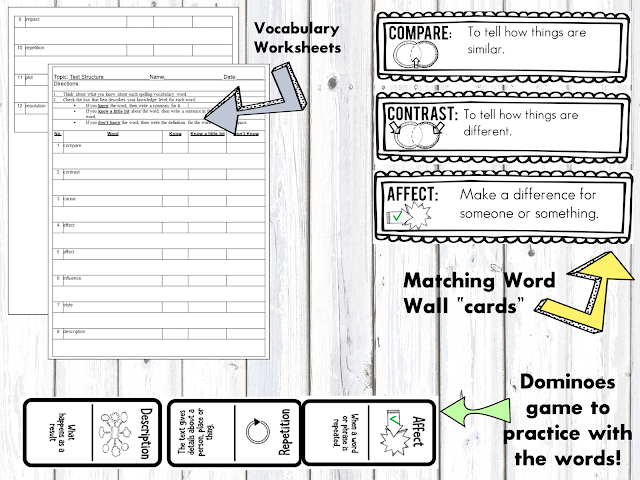It's one thing to know what text structure IS, but it's another thing to know how to USE text structure. For me, this is the struggle point for my middle schoolers.
They'll gleefully tell me that a text uses the compare/contrast text structure but when I dig a bit deeper and ask things like "How does knowing that help you understand the text?", I get blank stares. That's because they've never been asked to USE them. Well, now is the time!
How I teach students to USE text structures
1. First I start with vocabulary.
I include words they know like compare and contrast with words they might not have thought are connected like affect and effect.Students record the definitions & what they know about the word. I hang word wall cards as we go over the words. Afterwards, students play a dominoes game to help those words stick!
Recently, I created a digital version of the vocabulary complete with digital organizers, digital puzzle practice where students match up the words with the definitions to reveal a secret picture and then a self-grading quiz!
2. Teach
I teach the students a 3 step process for using text structure to analyze texts with a text, some notes and a PowerPoint. The notes are my own design of traditional two column notes blended with interactive visuals. I call them Pixanotes.There are 4 versions of the notes all with the same content but different levels of scaffolding. One version has fill in the blanks while another has pre-printed content. The idea is that if you have students with special needs or limited English mixed in with general education students, you could have all 4 versions out in the same class at the same time and everyone would have something with which they could work.
3. Processing Time (Practice)
After the notes, it's time for the student to process the information that was presented. I sometimes use task cards for this and other times, I use a menu with 2 options and a new text.After we have completed the processing phase, then it's time to have a quiz. After the quiz, I'll know who's "got it" (those are the students who score 80% or better), and I'll also know who didn't "get it" (those that scored below 80%). So that leads me to the final phase of the unit...
4. Reteach and Enrich
I use menus for this phase of the unit so that everyone has something to do which looks similar. The students who need reteaching get an "enhancement" menu while those who are ready for enrichment get a menu that says "enrichment". The choices are different and I tell students that everyone is getting the menu that is most appropriate for their needs. Period. If a student says "Why do I have this menu and not the one he has?", I reply with "This is the menu you need and this is the menu he needs."The Reteach provides more support in reviewing the basics while the Enrichment menu asks the students to create something new. Sometimes we use the products that are created in this phase to review before a final assessment.
I do not currently have a plan for reteach/enrich in the digital environment other than to offer students the opportunity to make text corrections (reteach) or to make something new like a review game (enrich).
The benefit to this process:
This process that I have shared with you, is what I call the
Teach-->Reteach-->Enrich method which you may have noticed has built-in differentiation for all 3 areas!
The content (notes) are differentiated, the processing is differentiated through choice, and the reteach/enrichment activities allows for differentiation of products. Now I can be sure I am prepared to help reach all learners!
Ready to try this text structure unit out with your students?
All the work is done in the Complete Unit Printable Bundle - just make the copies and teach!
 |
| Each part is also sold separately. |
You might also be interested in the digital bundle that has vocabulary with organizers, a practice game and a self-grading quiz, differentiated notes, a practice game and a final self-grading assessment.
I hope these ideas help you and your middle school students use text structures to analyze text!
Thanks for stopping by!
Pin This Post for Later:
Don’t spend hours searching for that great idea you found. Just pin this to your favorite classroom Pinterest board so you can quickly and easily come back when you are ready. You’ll be glad you did!









